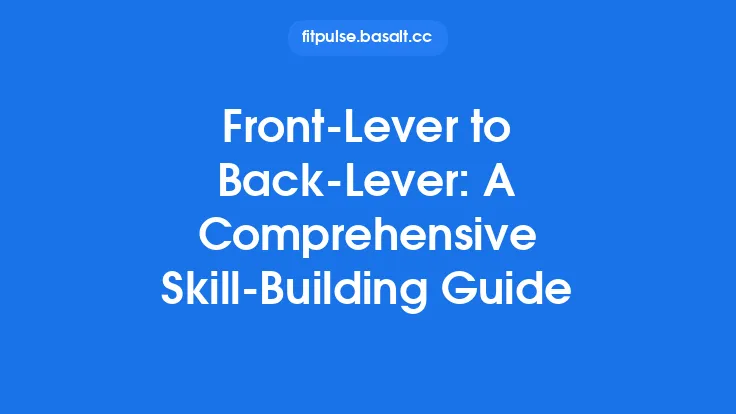Calisthenics is more than a collection of impressive tricks; it is a disciplined art of moving your body through space using only the weight of your own skeleton. Mastering the iconic skills—handstand, muscle‑up, front lever, planche, human flag, and beyond—requires a systematic, equipment‑agnostic approach that blends biomechanics, progressive overload, periodization, and neuro‑motor learning. This guide walks you through the essential components of a skill‑centric program design, offering a step‑by‑step framework that can be applied whether you train on a park bench, a playground bar, or a simple pull‑up bar at home.
Understanding the Foundations of Calisthenics Skill Development
1. Biomechanical Prerequisites
Every advanced calisthenics skill can be broken down into a series of joint actions and muscular demands. Mapping these requirements clarifies which foundational movements must be mastered first. For example, a full‑front lever demands:
- Shoulder extension and scapular retraction – primary drivers for maintaining a horizontal torso.
- Latissimus dorsi and teres major activation – to generate the pulling force.
- Core rigidity – to prevent lumbar hyperextension.
By charting the joint moments and muscle activation patterns, you can identify gaps in strength, stability, or mobility that would otherwise stall progress.
2. Motor Learning Stages
Skill acquisition follows the classic three‑stage model:
- Cognitive Stage – the athlete consciously thinks about each movement component.
- Associative Stage – the movement becomes smoother; errors are corrected more quickly.
- Autonomous Stage – the skill is performed with minimal conscious effort, freeing mental bandwidth for variations or combinations.
Designing a program that respects these stages ensures that training volume and complexity are matched to the learner’s current neuro‑motor capacity.
3. The Role of Body Awareness
Proprioceptive acuity is a cornerstone of calisthenics. Drills that emphasize “feeling” the line of tension—such as slow‑tempo holds, isometric squeezes, and controlled eccentric phases—train the nervous system to recruit the correct motor units consistently.
The Anatomy of a Skill Progression Framework
1. Defining the End Goal
Start with a clear, measurable endpoint. Instead of a vague “learn handstand,” specify “hold a freestanding handstand for 30 seconds with less than 5° of sway.” This target informs the selection of intermediate milestones.
2. Mapping the Progression Ladder
Create a hierarchical list of regressions and progressions. For a muscle‑up, a typical ladder might look like:
- Dead‑Hang Pull‑Up – pure vertical pulling.
- Chest‑to‑Bar Pull‑Up – increased range of motion.
- Kipping Pull‑Up – introduces hip drive.
- Transition Negative – lower from the top of the dip to the bottom of the pull‑up.
- Assisted Muscle‑Up (band or partner) – reduces load on the transition.
- Full Muscle‑Up – unassisted, fluid motion.
Each rung should be achievable with a high success rate (≈80‑90 %) before moving upward, ensuring the nervous system consolidates the new pattern.
3. Quantifying Load Without Equipment
In the absence of external weights, overload is generated by manipulating:
- Leverage – moving the center of mass further from the pivot (e.g., elevated feet on a pull‑up).
- Tempo – slowing eccentric or concentric phases (e.g., 5‑second descent).
- Volume – increasing sets, reps, or total time under tension.
- Complexity – adding a secondary movement (e.g., handstand walk after a static hold).
These variables provide a continuum of difficulty that can be precisely programmed.
Periodization Strategies for Skill Mastery
1. Macro‑Cycles (12‑24 Weeks)
Divide the year into 2‑3 macro‑cycles, each dedicated to a primary skill or a cluster of related skills. A typical macro‑cycle might allocate:
- Weeks 1‑4: Foundation building (strength, stability, mobility specific to the skill).
- Weeks 5‑8: Skill‑specific volume (high‑frequency practice of progressions).
- Weeks 9‑12: Peak phase (low volume, high intensity, performance testing).
2. Micro‑Cycles (Weekly Layout)
Within each week, balance three training modalities:
| Day | Focus | Example Session |
|---|---|---|
| Mon | Strength & Hypertrophy | Weighted pull‑ups (if possible) or elevated‑feet pull‑ups, 4 × 6‑8 |
| Tue | Skill Technique | Handstand wall‑facing holds, 6 × 30 s + 3 × 10 s freestanding attempts |
| Wed | Active Recovery | Light mobility, joint‑circulation drills (no heavy loading) |
| Thu | Power & Transition | Muscle‑up transition negatives, 5 × 3‑5 |
| Fri | Endurance & Volume | 5 × max‑rep body rows, 3 × 30‑second front‑lever tucks |
| Sat | Test & Review | Attempt target skill, record metrics, adjust progression ladder |
| Sun | Rest | Full recovery |
The weekly plan emphasizes frequent skill exposure (minimum 3‑4 sessions per skill) while allowing adequate recovery for the high‑intensity neuromuscular demands.
3. Deload and Reset Phases
Every 4‑6 weeks, incorporate a deload week where volume is reduced by 30‑40 % and intensity is moderated. This prevents over‑training of the central nervous system, which is especially critical for complex motor patterns.
Designing Progressive Overload Without External Load
1. Lever Manipulation
- Elevated Feet Pull‑Ups: Shifts the line of force, increasing lat activation.
- Archer Pull‑Ups: One arm bears more load, creating an asymmetrical lever.
- One‑Arm Assisted Pull‑Ups: Use a grip on the opposite hand for partial assistance, gradually reducing support.
2. Tempo Control
Implement the “4‑2‑1” rule: 4 seconds eccentric, 2 seconds pause at the bottom, 1 second concentric. This dramatically raises time‑under‑tension, stimulating strength gains.
3. Isometric Holds
Static positions (e.g., tucked front lever, L‑sit) are excellent for building joint stability and muscular endurance. Progress by extending hold duration or transitioning to more demanding variations (e.g., from tucked to advanced tuck to straddle).
4. Plyometric‑Style Explosiveness (Skill‑Specific)
While the article avoids generic plyometric programming, incorporating explosive elements directly tied to a skill—such as “explosive pull‑up to chest” for the muscle‑up transition—provides a targeted overload.
Regression and Scaling Techniques
1. Band‑Assisted Variations (Equipment‑Agnostic Perspective)
If bands are unavailable, use a partner’s support or a low‑height platform to reduce the effective load. The key is to maintain the same movement pattern while adjusting difficulty.
2. Partial Range of Motion
Begin with a reduced ROM (e.g., half‑front lever) and incrementally increase the angle as strength improves. This method preserves the mechanical specificity of the skill while allowing early success.
3. Positional Modifications
- Handstand Against a Wall (Facing vs. Backing): Facing the wall emphasizes balance, while backing the wall focuses on strength. Choose based on the athlete’s current stage.
- Planche on Parallettes vs. Floor: Parallettes reduce wrist strain and allow a more upright torso, serving as a regression for the planche.
Core Principles for Specific Flagship Skills
Handstand
- Progression Ladder: Wall‑Facing Hold → Wall‑Kick‑Ups → Freestanding Hold → Handstand Walk.
- Key Metrics: Hold time, sway angle (measured with a smartphone app), foot placement consistency.
- Programming Tip: Practice handstand drills at the start of each session when the nervous system is fresh; allocate 10‑15 minutes of focused work.
Muscle‑Up
- Transition Mastery: Use “false grip” on the bar to shorten the distance between the wrist and the bar, facilitating a smoother pull‑to‑dip transition.
- Overload Variables: Add a “slow‑pull” phase (3‑4 seconds) before the explosive transition to increase strength in the pulling portion.
Front Lever
- Progression Ladder: Tuck → Advanced Tuck → Straddle → Full‑Body.
- Training Focus: Scapular depression and lat engagement; incorporate “scapular pull‑ups” and “straight‑arm lat raises” as accessory work.
Planche
- Progression Ladder: Frog Stand → Tuck Planche → Advanced Tuck → Straddle → Full Planche.
- Accessory Emphasis: Wrist conditioning (wrist push‑ups, extensions) and scapular protraction drills (planche leans, scapular push‑ups).
Human Flag
- Progression Ladder: Side‑Plank → Tuck Flag → Straddle Flag → Full Flag.
- Critical Strength Areas: Oblique and lat isometric strength; incorporate “side‑lying holds” and “lat pull‑overs” using body weight.
Monitoring, Feedback, and Adaptation
1. Objective Data Collection
- Video Analysis: Record each skill attempt from multiple angles; use frame‑by‑frame playback to spot technical flaws.
- Performance Logs: Track hold times, rep counts, and perceived exertion (RPE) for each progression.
2. Subjective Indicators
- Neuromuscular Fatigue: Notice tremors, loss of form, or prolonged soreness—signals to adjust volume.
- Motivation & Confidence: A sudden drop may indicate over‑training or insufficient skill variety; incorporate a “fun” variation to re‑engage.
3. Adaptive Programming
When a plateau persists for >3 weeks, apply one of the following:
- Increase Load Variable: Add tempo or lever difficulty.
- Decrease Volume: Allow more recovery, then re‑introduce higher intensity.
- Change Skill Focus: Rotate to a complementary skill (e.g., from handstand to planche) to maintain neural stimulus while the primary skill consolidates.
Programming Considerations for Longevity and Injury Prevention
- Balanced Muscular Development – Pair pulling skills with pushing counterparts (e.g., planche work with front‑lever rows) to avoid shoulder imbalances.
- Joint‑Specific Conditioning – Include wrist, elbow, and shoulder prehab drills (band dislocates, scapular wall slides) at the end of each session.
- Periodized Rest – Schedule at least one full rest day per week and a “light week” every 6‑8 weeks where the focus shifts to technique rather than intensity.
- Progressive Skill Density – Gradually increase the number of skill‑specific sets per week; avoid jumping from 2 to 5 sessions abruptly.
Mental and Neuromuscular Conditioning
- Visualization: Spend 2‑3 minutes before each training block mentally rehearsing the movement pattern; this primes the motor cortex.
- Breath Control: Coordinated breathing (inhale during eccentric, exhale during concentric) stabilizes intra‑abdominal pressure, enhancing core rigidity.
- Goal Chunking: Break a 30‑second handstand goal into three 10‑second sub‑goals, reinforcing incremental success and reducing performance anxiety.
Tracking Progress and Adjusting the Plan
| Metric | Tool | Frequency | Adjustment Trigger |
|---|---|---|---|
| Hold Time (s) | Stopwatch | Every session | < 5 % improvement over 2 weeks → increase difficulty |
| Sway Angle (°) | Smartphone inclinometer app | Weekly | > 10° deviation → add balance drills |
| Reps at Progression | Training log | Weekly | Stagnation > 3 weeks → modify tempo or add lever load |
| RPE (1‑10) | Subjective rating | Every session | RPE ≥ 8 for 2 consecutive sessions → deload |
Regularly reviewing this matrix ensures the program remains aligned with the athlete’s evolving capacity.
Frequently Overlooked Nuances
- Grip Positioning: Small changes (e.g., neutral vs. pronated) can shift the load distribution across the forearm and shoulder, influencing progression speed.
- Surface Compliance: Training on a slightly softer surface (grass, rubber mat) can reduce impact forces during explosive transitions, allowing higher quality repetitions.
- Temperature & Flexibility: Warm muscles exhibit greater joint range, which can be critical for achieving the full extension required in a front lever or planche. A brief dynamic warm‑up targeting the target joints is essential.
- Recovery Nutrition: Even in equipment‑agnostic programs, adequate protein (≈1.6 g/kg body weight) and carbohydrate intake support muscle repair and glycogen replenishment, accelerating skill consolidation.
Closing Thoughts
Mastering calisthenics skills is a marathon of deliberate practice, scientific programming, and mindful adaptation. By dissecting each skill into its biomechanical components, constructing a clear progression ladder, and applying equipment‑agnostic overload principles, you can design a training system that yields consistent, measurable gains—whether you’re training on a city park bar or a modest home pull‑up bar. Remember that the journey is as valuable as the destination: each incremental improvement refines body awareness, builds resilience, and deepens the connection between mind and movement. Embrace the process, track your data, and let the progressive framework guide you toward the next level of calisthenics mastery.





